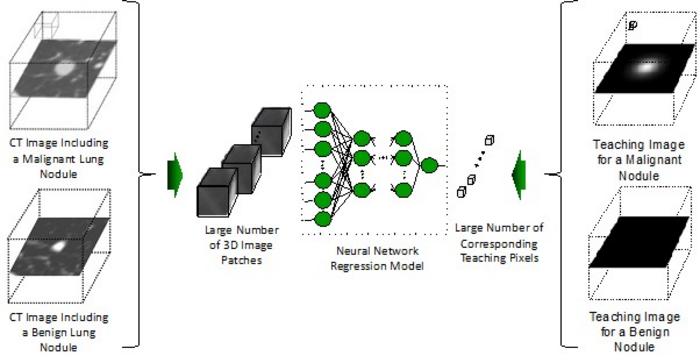Imagine a future where the diagnosis of lung cancer no longer necessitates access to supercomputers or expensive, high-power graphic processing units. This future, once considered the domain of speculative fiction, has been brought to life by Professor Kenji Suzuki and his team at the newly established Institute of Science Tokyo. During the 2024 Radiological Society of North America (RSNA) Annual Meeting, they revealed an ultra-lightweight artificial intelligence (AI) model capable of performing lung cancer diagnostics with astonishing efficiency, all on a standard laptop computer.
The innovation pivots around a unique deep learning methodology termed the massive-training artificial neural network (MTANN). Unlike conventional AI systems, which demand vast datasets often requiring thousands or millions of annotated medical images, Suzuki’s MTANN thrives on remarkably minimal data. The system learns directly from pixel-level information extracted from computed tomography (CT) scans, drastically minimizing the training dataset to only 68 cases. This represents a colossal leap forward, circumventing the long-standing challenge of data scarcity in medical AI.
Cutting-edge deep learning architectures like Vision Transformer and 3D ResNet are usually the benchmarks in AI-based diagnosis, but Suzuki’s model outperforms these state-of-the-art (SOTA) frameworks despite their dependency on massive datasets. The MTANN approach achieved a remarkable area under the curve (AUC) of 0.92, compared to significantly lower scores from Vision Transformer and 3D ResNet models, which scored 0.53 and 0.59, respectively. This disparity underscores the efficacy of Suzuki’s approach, which also benefits from speed and portability.
Training efficiency is another standout feature of this MTANN model. Entirely trained on a commercial-grade laptop computer without specialized hardware, the process took a mere 8 minutes and 20 seconds — a fraction of the time and cost typically associated with large-scale AI training on data center infrastructures. Moreover, once trained, the system processes diagnostic predictions in just 47 milliseconds per patient case. This unprecedented speed not only streamlines clinical workflows but also expands AI’s accessibility to institutions with limited technological resources.
The implications of such technology go beyond mere cost and speed improvements. Suzuki emphasizes that this AI approach democratizes medical diagnostics, especially benefiting rare diseases where collecting extensive datasets is challenging or impossible. By reducing dependency on massive data volumes or expensive hardware, this innovation has the potential to empower healthcare providers worldwide — from well-equipped urban hospitals to rural clinics.
Another critical aspect of this breakthrough lies in its environmental impact. Conventional AI development and deployment, particularly those involving data centers filled with GPUs, pose enormous energy consumption challenges. The MTANN’s low resource demand translates into substantially reduced power usage, addressing the looming global energy concerns associated with the exponential growth in AI applications.
Suzuki’s research did not go unnoticed. At RSNA 2024, the work was honored with the prestigious Cum Laude Award, a distinction awarded to only 1.45% of all presentations. This recognition signifies the profound scientific value and impact potential embodied in the ultra-lightweight AI model — a testament to the team’s ingenuity and meticulous craftsmanship.
The MTANN concept has a storied history, dating back to Suzuki’s pioneering work in the early 2000s. Having developed one of the earliest deep learning models for medical imaging, Suzuki has continuously refined this technology over two and a half decades. With a prolific portfolio of over 400 scholarly articles and more than 40 patents — many of which have been commercialized — his work bridges the gap between cutting-edge AI theory and real-world clinical application.
His stature within the scientific community is exemplified not only by his research output but also through leadership roles, including chairing a session at the 39th Annual AAAI Conference on Artificial Intelligence. Furthermore, Suzuki received two of RSNA’s highest honors in 2024 and is ranked among the top 2% of scientists globally, cementing his influence in the AI and biomedical research arena.
Fostering interdisciplinary collaboration is a key driver behind Suzuki’s approach. Merging engineering, computer science, and medical knowledge, his team operates within a dynamic research environment that pushes the boundaries of biomedical AI. This synergy accelerates the translation of novel algorithms into practical diagnostic tools ready for real-world deployment, ensuring that theoretical breakthroughs positively impact patient care.
Looking forward, Suzuki and his collaborators envision expanding the scope of ultra-lightweight AI systems. Their work provides a blueprint for developing compact, high-performance models tailored to an array of medical imaging challenges, beyond lung cancer, and potentially other diagnostic modalities. This paradigm shift heralds a new era where AI’s power is harnessed efficiently, equitably, and sustainably.
The foundation of the Institute of Science Tokyo, officially established in October 2024 through the merger of Tokyo Medical and Dental University and Tokyo Institute of Technology, fosters this interdisciplinary and innovative atmosphere. With a mission centered on advancing science to enhance human wellbeing, the institute provides a fertile environment for breakthroughs such as Suzuki’s AI cancer diagnostic model.
In summation, the ultra-lightweight MTANN-based AI model stands as an extraordinary advancement in medical technology. It redefines the possibilities of AI diagnostics by combining efficiency, accessibility, and environmental responsibility. By enabling powerful diagnostic tools on everyday computing devices, its ripple effects could revolutionize cancer diagnosis globally, making high-quality healthcare attainable regardless of geographical or economic barriers.
Subject of Research: Artificial Intelligence for Lung Cancer Diagnosis
Article Title: Ultra-Lightweight AI Model Revolutionizes Lung Cancer Diagnosis on Standard Laptops
News Publication Date: 2024 (RSNA Annual Meeting)
Web References:
- Radiological Society of North America (RSNA) 2024 Annual Meeting: https://www.rsna.org/annual-meeting
- MTANN Deep Learning Approach: https://www.isct.ac.jp/ja/news/acnrfdt9dcto#note1
- AAAI Conference on Artificial Intelligence: https://aaai.org/conference/aaai/aaai-25/
- RSNA Highest Distinctions: https://suzukilab.first.iir.titech.ac.jp/news/news-4139/
Image Credits: Kenji Suzuki, Institute of Science Tokyo
Keywords: Cancer, Lung cancer, Artificial intelligence, Medical technology, Neural networks, Computerized axial tomography, Health and medicine, Cancer risk




